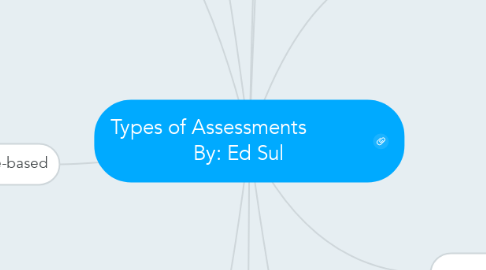
1. performance-based
1.1. more open-ended assessment that gives students multiple stimuli in order to solve a problem or create something
1.1.1. advantages
1.1.1.1. allows for differentiation, aligned with 21st century learning goals
1.1.2. disadvantages
1.1.2.1. Time requirement may be too muc
1.2. Assessment OF learning. The student successful completion of the assessment demonstrates a certain level of mastery of the addressed subjects.
1.3. Ex) Performance of a part of play
2. high-stakes
2.1. single, defined assessment that has direct consequences for passing or failing
2.1.1. advantages
2.1.1.1. Repeatable and Scalable
2.1.2. disadvantages
2.1.2.1. student may be a poor test-taker, teacher are held accountable for student achievement when there could be outside actors such as low socioeconomic backgrounds contributing to poor achievement
2.2. Assessment OF learning. The test is design specifically to see how much students have learned.
2.3. ex) SAT Reading section
3. authentic
3.1. task driven assessments that demonstrate meaningful applications, which are commonly accompanied by a rubric
3.1.1. advantages
3.1.1.1. involves 21st century skills
3.1.1.2. Offers real-world experience to the students
3.1.2. disadvanatges
3.1.2.1. Feasibility and time constraints may be issues
3.2. Assessment FOR learning. The students are allowed to apply their classroom knowledge to real-world problems
3.3. Ex) Write a grant proposal following the given requirements.
4. self-assessment
4.1. evaluating oneself in order to assess certain aspects
4.1.1. advanatges
4.1.1.1. allows the student to reflect on their own learning and abilities, encourages student involvement and responsibility
4.1.2. disadvantagees
4.1.2.1. Students are unable to assess their work appropriately or accurately
4.1.2.2. Grades can become inflated
4.2. Assessment FOR Learning
4.2.1. Students use this type of assessment to see how they are doing so they can improve and address areas of need.
4.3. Ex) Students self-edit their work based off a given rubric.
5. Resources
5.1. Center for Teaching and Learning. Methods of Assessment. Retrieved 8/13/15. ctl.utexas.edu/teaching/assess-learning/methods-overview
5.2. Mueller, John (n.d) Authentic Assessment Toolbox. Retrieved 8/13/15 http://jfmueller.faculty.noctrl.edu/toolbox/whatisit.htm
5.3. Ronan, A (2015, April 29). Every Teacher's Guide to Assessment. Retrieved August 13, 2015. http://www.edudemic.com/summative-and-formative-assessments/
5.4. Self and Peer Assessments (n.d.) Retrieved August 13, 2015 http://sydney.edu.au/education_social_work/groupwork/docs/SelfPeerAssessment.pdf
6. formative
6.1. used throughout a unit to determine how well students are learning specific goals
6.1.1. advantages
6.1.1.1. allows the teacher to identify areas of weakness before a summative assessment
6.1.2. disadvantages
6.1.2.1. Not comprehensive
6.2. Assessment FOR learning
6.2.1. The purpose of these assessments is to identify gaps in understanding so they can be addressed.
6.3. Ex) Exit ticket: A written response at the end of the day to see what the students understood.
7. summative
7.1. used at the end of a unit to determine how well students mastered a topic after instruction
7.1.1. advantages
7.1.1.1. Comprehensive. Can be used as a motivation tool.
7.1.2. disadvantages
7.1.2.1. May not accurately capture the understanding of all learning styles.
7.1.2.2. Does not provide a clear picture of why students may not have done well
7.2. Assessment OF learning
7.2.1. The main purpose of the test is to gauge how much knowledge the students have gained and can demonstrate
7.3. Ex) A final exam on Shakespeare in multiple choice and short answer format
8. portfolio
8.1. collection of student-developed artifacts that documents the learning process
8.1.1. advantages
8.1.1.1. Can be a comprehensive assessment of a student over the course of a long period of time.
8.1.1.2. Can address different learning styles
8.1.1.3. Allows for cross content analysis
8.1.2. disadvantages
8.1.2.1. May not be realistically possible in many situations.
8.1.2.2. Can put students who move around at a disadvantage
8.1.2.3. May not have enough resources to conduct such an assessment
8.2. Assessment OF learning
8.2.1. The portfolio by definition is a comprehensive analysis of a student's body of work through out a given period of time
8.3. Ex) Collection of student work throughout the year.
9. peer assessment
9.1. peers grade assessments based on teacher benchmarks
9.1.1. advantages
9.1.1.1. provides more relevant feedback since it is coming from their peers
9.1.2. disadvantages
9.1.2.1. students may grade unfairly, students do not feel comfortable judging another students work
9.2. Assessment FOR learning
9.2.1. Students can learn through both sides of the assessment. By assessing and by being assessed students can learn
9.3. Ex) Peer editing of essays
10. diagnostic
10.1. similiar to a pre-test, given at the beginning of a unit to see how much students already now
10.1.1. advantages
10.1.1.1. identifies students weakness, strengths, and prior knowledge
10.1.2. disadvantages
10.1.2.1. Can limit differentiation possibilities
10.2. Assessment FOR learning
10.2.1. The goal here is to see what areas students need support to improve their understanding.

